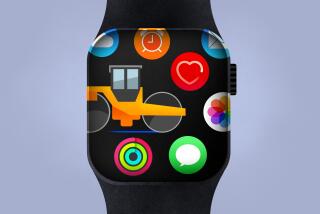Just Speak into the Shirt Cuff
- Share via
Etiquette memo for the millennium:
When addressing your shirt cuff, speak clearly.
If you must play your musical jeans jacket, do so judiciously.
Please do not broadcast directly from your underwear.
Now wait. Before you dismiss these tips as the detritus from some far-out prognostication du jour, consider the source. Serious scientists from the Massachusetts Institute of Technology, physicists, engineers, chemists, computer specialists--people with PhDs!--are developing clothing that will think, talk and transmit vital information.
Just as DuPont developed Dacron, bringing us polyester and other synthetics in the 1950s, corporate America is behind this push. Backing the MIT research are companies, including Nike, that view clothing as equipment, designed to improve or monitor performance. But the applications go well beyond the sports bra that measures your pulse or alerts you to dehydration. The fibers that go into business suits will soon incorporate such workaday tools as cell phones and Palm Pilots. High fashion it’s not--yet. Designers who fuss over the drape of fine fabrics are not exactly poised to wire their exquisitely tailored garments, perhaps because there’s no word on how we’ll clean them.
Still, wearable intelligence is about to transform the material world. Above all, fashion establishes identity, says Valerie Steele, curator of the museum at New York’s Fashion Institute of Technology. Few people depend on deep ridges on their shoes for traction, and no one weighing more than 82 pounds needs the snug fit of spandex. Wearing either tells the world who you are. And smart clothing is the future benchmark of cool, Steele says. Without it, “you look like a strange Luddite, like, why don’t you have a cell phone wired into your suit?”
The market potential of these innovations is huge, says Jud Early, a vice president and director of research and development at TC Squared, a North Carolina nonprofit that seeks to improve competition in U.S. companies. “Once the technological breakthroughs are made, these products can become mainstream, certainly,” he says.
For now, Michael Hawley, an MIT professor of media technology, suffers the indignity of juggling his cell phone, Palm Pilot and laptop. Since MIT is the top spot for such research, he travels constantly, lecturing and consulting with other techno-brains. It’s Brazil this week, China before that. (He keeps a photograph of a Miss Universe in his office so he’ll be sure to recognize her in an airport somewhere and instantly sweep her off her feet.) Soon, he promises, we’ll all have “wearable objects”--MIT code for clothing with these devices built in. Our bodies will be part
of the package, serving as data networks, or
informational go-betweens. Instead of exchanging business cards, we’ll merely shake hands to transmit the usual info, plus other useful morsels. (Would it pay to know the person you’re doing business with once dated your sister and it ended badly?) Likewise, the sole of your shoe, better a Rockport walker than a Manolo Blahnik stiletto, might provide access to stock reports or real-estate stats. “Makes more sense than a laptop,” Hawley observes. “Tie your shoes and you’re hooked up.”
With an annual budget of $30 million--90% of it from corporate sponsors such as Nike, Levi Strauss & Co. and Swatch--research on at least 200 separate projects at the MIT Media Laboratory takes place in a stark concrete building designed by I.M. Pei. A bust in its lobby by French sculptor Auguste Rodin is one of the few objects that is not wired for sound (smell, taste, etc.). Here, the employee coffee machine not only thinks, it talks. Reacting to tiny chips on the bottom of a user’s cup, it customizes their caffeine, and if desired, provides musical accompaniment. “Good morning, Alexandra,” it chirps to one Media Lab staffer. “I am making your coffee with milk, no sugar, the way you like it. While it’s brewing, I will turn on your favorite radio program, NPR.”
Among the men here, it’s easy to recognize the senior scientists because they all have beards. Many of the junior scientists look too young to shave. That’s all right: What they’re doing looks more like play than work. Alex Pentland, the lab’s academic director, insists that while his staff does invent musical squeeze balls that teach babies to love Beethoven . . . or musical Play-Doh . . . it has have every bit as much credibility as colleagues who ponder new ways to blow up the universe. The MIT imprimatur helps, Pentland says. So does the fact that their field is expanding so drastically, producing stunning advances in chips and other micro-communications units.
In the drive to get digital technology off the desktop and into the objects around us, scientists have masterminded a chair that recognizes each person who plops down, immediately adjusting for height and weight. And a smart car takes into account individual driving habits. Consider how fast all this is happening. Five years ago, few of us lived or died on the Internet. We did not check e-mail before checking in with our spouses. Five years from now we will almost certainly own some form of wearable intelligence. We may even buy it at Target.
Long before Ralph Lauren equips his collection with no-see-’em telephones, however, other problems must be addressed. Privacy is a big concern, Pentland says. How will your smart clothes know not to share information? For example, knowing that the client you just met years ago dumped your favorite sister may jeopardize an otherwise lucrative business deal. It would take time to access such information on a computer or Palm Pilot. Get it instantly, while you’re shaking hands, and instead of talking contracts, you may want to punch the jerk. Similarly, do you really want a stranger being privy to your weight, age and what really happened at your last job?
One MIT researcher has been designated to develop a component that will filter and sort information for each user--so your shirt won’t beep or ring in the middle of a face-to-face conversation the way your cell phone inevitably does. Beyond that, just how the wearables will account for individual situations and preferences is uncertain. We all know how miserable life is when a computer malfunctions. What if that computer woven into your suit melts down during an important presentation? What happens to the communications system based in the sole of your shoe if you inadvertently slog through a puddle? Will we all feel like air traffic control towers, or communications satellites?
Pentland dismisses the worriers. Dire predictions, he notes, surrounded the invention of the printing press. “You heard all this doom and gloom, this talk about how books will ruin the church and change the culture. And you know what? They were right. We got democracy.”
“Wearable” may still be a stretch for the smart clothes developed so far, and “attractive” also is subjective. Fabrics from the MIT lab are made of stainless steel and a Kevlar composite, with roughly the texture of a Teflon frying pan. The researchers, refusing to perpetuate the stale old stereotype of scientists as fashion geeks, hope to marry engineered fibers with natural ones. “I’m not going to buy polyester wearable computers,” Pentland protests. “I’ll buy silk and wool. But hidden in it will be metallic threads”--the crucial conductor units.
With stores on New York’s Madison Avenue and in Palm Beach, Boston designer Alfred Fiandaca says none of this is remotely farfetched. Micro fibers made out of recycled plastic bottles are an industry staple, he points out. And more than a dozen years ago, he adds, the U.S. government used fabrics that control body temperature, allowing the same garment to be worn at subzero temperatures or at 150 degrees. “Communications wired into the fibers? Sure, why not?” Fiandaca says.
Already, MIT has added to fashion’s lexicon. “E-broidery” refers to designs woven to access the garment’s “intelligence.” Cellist Yo-Yo Ma soon will tour with a musical denim jacket underwritten by Levi Strauss. The music is made by touching the E-broidery, activating a play list ranging from Beethoven to the Beatles. It’s a “cool new world,” Pentland says.
Wearable intelligence may also help produce a healthier world. Heart attacks account for $130 billion of an annual U.S. health-care budget of $1 trillion. Only 10% of the 1.5 million heart attacks are treated in time to save the victim. MIT’s new wristwatches will monitor the morphology of the heart valve, facilitating early detection and treatment. MIT also has worked with New York jeweler Harry Winston to design a $500,000 heart-throb brooch. With each beat, the rubies in this little bibelot light up.
Clothing that contributes to better health is especially likely to take off with consumers, says Early of TC Squared. Imagine, for example, the applications for women at high risk genetically for breast cancer, Early suggests. “She’d be very well served by a bra that could say, ‘Hey, we’ve got a problem developing here, let’s go get that mammogram now and not wait ‘til May.’ ”
Marvin Traub, the former board chairman of Bloomingdale’s and a veteran industry advisor, admits that the impending trend sounds weird. “But I think as people discover the potential, it will catch on very quickly.” He predicts “venturesome” designers such as Ralph Lauren will be among the first to offer high-end wearable intelligence. It’s not a reach to picture him making a smart suit or climate-controlled bedsheets, Traub says. But Traub does voice some reservations about the musical jacket. “Can you turn it off and on?” he wonders. “There are times when you would like to tell it to shut up.”
Anyone who shops at Barneys or Bijan won’t blink at the cost of wearable intelligence. For the rest of us, the prices will be less daunting than we might expect. Glasses equipped with mini PC screens will cost $100 to $200. Kids’ athletic footwear--with a locater to lead you to a lost child, to cite just one benefit--will run about $200. Computerized name tags to wear around your neck may cost as little as $20.
Accoutrements such as cell phones and computers bring out a competitive sense of style in all of us, says fashion historian Steele. “It’s like, I want the new one, the latest technical stuff. People used to be that way about fashion, but now it’s about technology. Like, I have this beautiful little cell phone, but I want to trade it in for a smaller, prettier, newer one.”
Once you get past the weirdness of wearable intelligence, it makes sense. You’re wearing a baseball cap anyway, so why not let its bill store your grocery list, or pointers from your tennis pro, or information about ancient Greece--or almost anything?
Pentland and his crew use terms like the phrase “augmenting the self” to describe the potential of their “ready-to-ware” line. CDs, photo albums, reference books, even warranties and receipts will be instantly available wherever we go. MIT physicist Neil Gershenfeld puts it this way: Wearable computers are nothing less than “a new step in our evolution as a species.” The inevitable step of moving clothing into computing, he argues, “opens a new era in how we interact with each other, the defining characteristic of what it means to be human.” Like Pentland and others in MIT’s media lab, Gershenfeld speaks clearly as he offers this assessment. He wants to make sure his shirt sleeve--or yours--can hear him.






